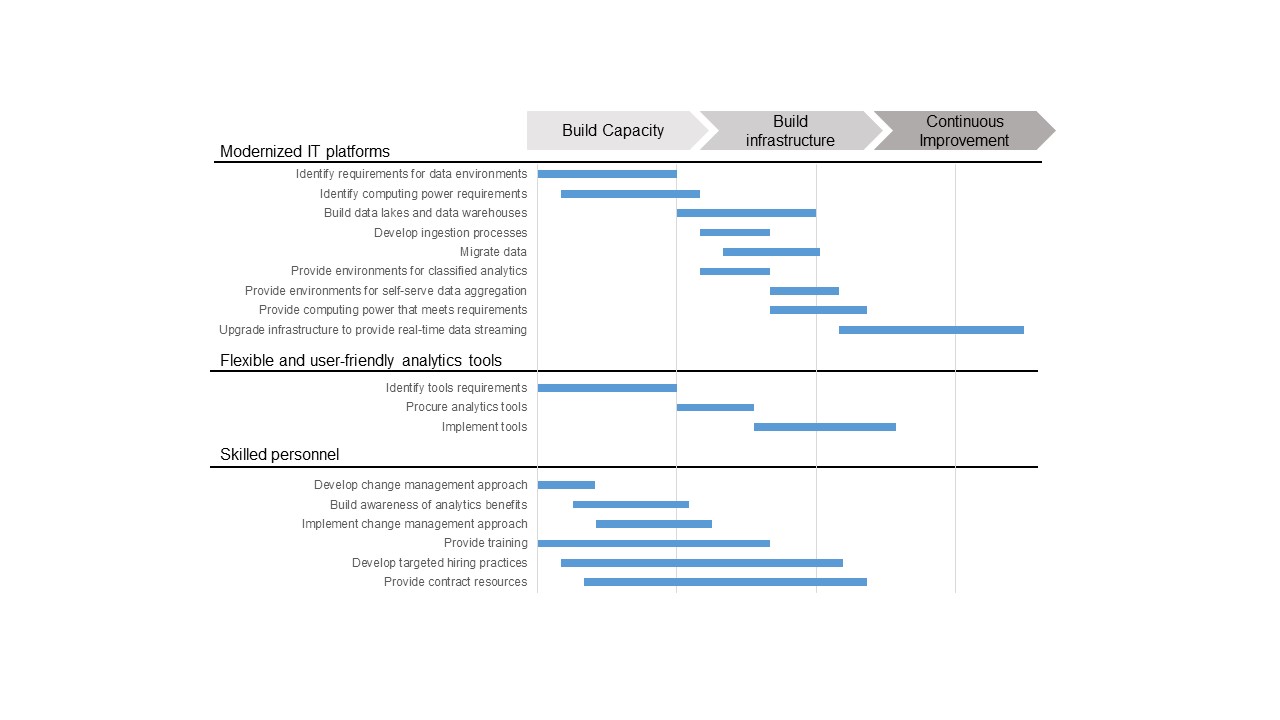High-Level Roadmap
On this page
To deliver on the stated vision a number of elements must be developed and available. They fall under three main categories:
- Modernized IT platforms that provide the ability to perform data ingestion in near real-time, perform analytics at the edge, provide data integration across multiple data sources, and perform analytics on unclassified and classified networks;
- Flexible and user-friendly analytics tools that provide the ability to perform analytics on both structured and unstructured data regardless of source, using both traditional BI and advanced analytics techniques; and
- Skilled personnel across the department who can support analytics throughout its lifecycle from the identification of requirements through to the maintenance of analytics products.
The following diagram outlines a high-level roadmap comprising a number of activities needed to deliver the above enablers

Figure 3: High-level roadmap
Build Capacity > Build infrastructure > Continuous improvement
Modernized IT platforms
- Identify requirements for data environments
- Identify computing power requirements
- Build data lakes and data warehouses
- Develop ingestion processes
- Migrate data
- Provide environments for classified analytics
- Provide environments for self-serve data aggregation
- Provide computing power that meets requirements
- Upgrade infrastructure to provide real-time data streaming
Flexible and user-friendly analytics tools
- Identify tools requirements
- Procure analytics tools
- Implement tools
Skilled personnel
- Develop change management approach
- Build awareness of analytics benefits
- Implement change management approach
- Provide training
- Develop targeted hiring practices
- Provide contract resources
The activities will be designed to deliver a mature analytics ecosystem across three stages:
- Stage 1 – Building capacity: In this stage, the focus is on building skills and awareness and investing in Defence Team members through targeted hiring and training. Additional activities will promote the change in culture, by recognizing the benefits and value that Defence has accrued using analytics. In preparation for the stage 2, requirements for tools, computing power and infrastructure (including cloud), as well as data access and control requirements, are gathered and documented. L1s continue to identify analytics use cases.
- Stage 2 – Building infrastructure: In this stage, the focus is on providing the tools and environments to develop analytics products. ADM(IM) will provide modern analytics tools and provide environments for data aggregation and analytics. The data migration plan will oversee the transfer of existing data to modern warehousing environments to support analytics. L1s will use best practices to build their own descriptive and diagnostic analytics, and will engage with data scientists to have advanced analytics models built. L1s will also assume responsibility for granting access to analytics products.
- Stage 3 – Continuous improvement: In this stage, DND/CAF has developed a mature analytics capability, and continuous improvement activities for skills, tools, and infrastructure are put in place. Data will continue to be migrated to data lakes and warehouses.
A more detailed roadmap with associated timelines is being developed as part of the Data Strategy Implementation Plan.
Key Considerations
The following are key considerations into the successful delivery of the vision. Without these, the achievement of the vision will be hampered.
- Executive support, with executives regularly and consistently communicating the benefits of analytics, and accessing or requesting analytics to inform their decisions.
- Talent and Resources, with Defence Team members having the appropriate skills to deliver on their roles, particularly in the areas of data management, data operations, data analytics and performance management.
- Security, with appropriate access and controls for data sources and analytics products at the appropriate places.
- Modern analytics infrastructure, with state-of-the-art user experience and integrated data sources (data lakes and warehouses) accessible in near real-time, which requires significant investment in all IT infrastructure and new architectural approaches.
Next Steps
To launch the delivery of the vision, the following are the activities to undertake in the near-term:
- Build the plan: Identify activities, schedules, milestones, and OPIs to deliver the roadmap as part of the Data Strategy Implementation Plan;
- Design change management approach: Identify change impacts to stakeholder groups, and identify ways and means to minimize resistance; and
- Establish a value realization approach: Identify mechanisms to measure and evaluate the value and benefits that Defence has accrued through the use of analytics, and implement an approach to monitor and report on those realized benefits.